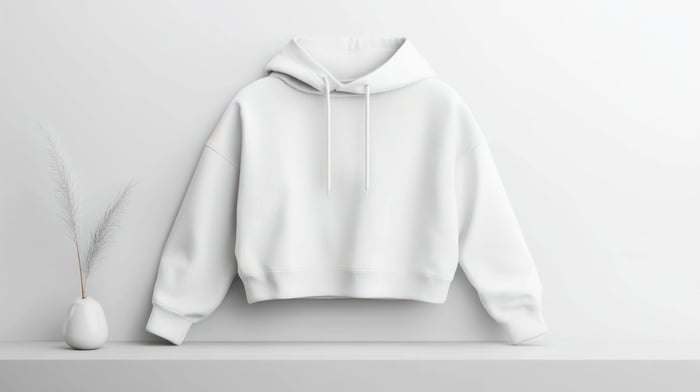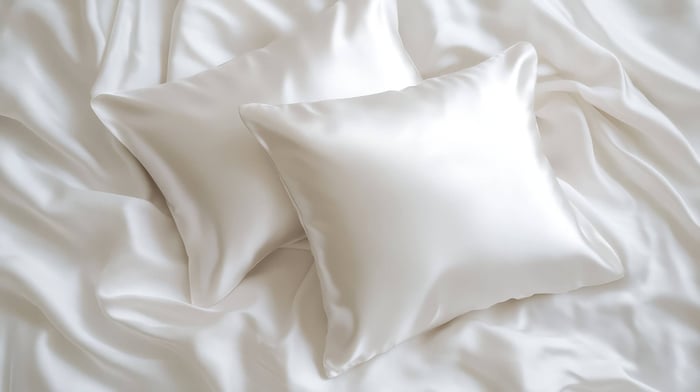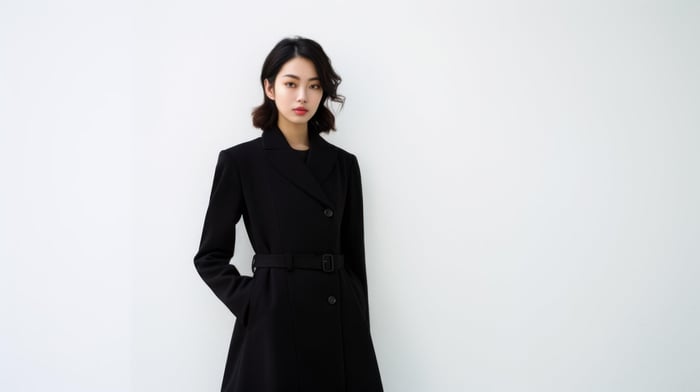 Lyocell fabric in natural light — discover what kind of fabric Lyocell is and why it’s the future of sustainable streetwear.
Lyocell fabric in natural light — discover what kind of fabric Lyocell is and why it’s the future of sustainable streetwear.Table of Contents
- Definition of Lyocell: Nature’s Tech-Forward Fiber
- Lyocell Fabric Characteristics: Why It’s a Game-Changer
- Sustainable Aspects of Lyocell: Fashion with a Conscience
- Comparing Lyocell to Other Fabrics: A New Standard in Comfort and Consciousness
- Uses of Lyocell: From Streetwear to Sleepwear
- Conclusion: Lyocell—The Fabric of the Future
- FAQs
When it comes to eco-friendly fashion, one question keeps popping up: what kind of fabric is Lyocell? For the new generation of conscious consumers, fabric isn’t just about feel—it’s about impact. Lyocell, a smooth and breathable fiber derived from wood pulp, has become the go-to material for sustainable streetwear and everyday essentials. Known for its silky touch, moisture-wicking performance, and closed-loop production process, Lyocell represents the balance between comfort, quality, and planet-first innovation. At EcoBear Wear, we see Lyocell not just as a fabric, but as the foundation of fashion that respects both people and the planet.
Definition of Lyocell: Nature’s Tech-Forward Fiber
Lyocell is a regenerated cellulose fiber made from sustainably sourced wood pulp—typically from eucalyptus, oak, or birch trees. Unlike conventional synthetic fabrics like polyester, which rely on petroleum-based materials, Lyocell comes from renewable resources and undergoes an eco-conscious transformation process. This fiber is produced through a closed-loop system that recycles over 99% of the solvent used, minimizing water waste and harmful emissions. That’s what makes Lyocell stand out in the conversation about circular fashion—it’s engineered for both performance and planet care.
In simple terms: Lyocell is a natural fabric that feels like luxury silk, performs like athletic wear, and carries the environmental footprint of a tree. It’s technically classified as a form of rayon, but its process is far cleaner and more sustainable than its predecessors like viscose or modal. That’s why major sustainable fashion labels—and innovators like EcoBear Wear—are building entire collections around Lyocell-based textiles.
If you’ve seen the name TENCEL™ Lyocell, that’s the trademarked version by Austrian company Lenzing AG, renowned for maintaining strict environmental standards. The name 'TENCEL™' has practically become synonymous with quality Lyocell fabric—one that delivers softness without the guilt.
 Eucalyptus trees — the natural source behind Lyocell, showing what kind of fabric Lyocell is and how it begins with renewable plant fibers.
Eucalyptus trees — the natural source behind Lyocell, showing what kind of fabric Lyocell is and how it begins with renewable plant fibers.How Lyocell Is Made
The production process of Lyocell is a fascinating example of bioengineering meets sustainability. It starts with sustainably harvested wood, which is chipped into small pieces and transformed into pulp. That pulp is then dissolved using a non-toxic organic solvent called N-methylmorpholine N-oxide (NMMO). Unlike viscose production, which uses harsh chemicals like carbon disulfide, NMMO is almost completely recycled back into the system in what’s called a 'closed-loop' process. This minimizes chemical leakage and reduces waste.
The resulting solution is extruded through fine spinnerets to form fibers, which are then washed, dried, and spun into yarn. The outcome? A fabric that feels naturally soft yet incredibly durable—ideal for both minimalist loungewear and high-performance activewear. For EcoBear Wear, this production method aligns perfectly with our ethos of mindful manufacturing: crafting pieces that look good, feel good, and do good.
Lyocell Fabric Characteristics: Why It’s a Game-Changer
Lyocell fabric isn’t just another eco buzzword—it’s redefining how we experience comfort and sustainability. Its unique molecular structure gives it high absorbency, breathability, and strength, even when wet. Here’s what makes it stand out in the sustainable fashion world:
- Softness: Lyocell has a naturally smooth fiber surface, making it gentle even on sensitive skin.
- Breathability: The fabric absorbs moisture efficiently and releases it quickly, preventing sweat build-up.
- Durability: Despite its delicate feel, Lyocell fibers are strong, holding shape after repeated washing.
- Sustainability: Made in a closed-loop system, Lyocell minimizes chemical waste and water usage.
- Versatility: From structured streetwear to flowy activewear, it adapts beautifully to different silhouettes.
Lyocell vs Cotton: The Sustainable Showdown
When it comes to Lyocell vs cotton, the differences go beyond texture—they define the future of conscious clothing. Cotton has long been a fashion staple, but it’s also resource-intensive, requiring massive amounts of water and pesticides to cultivate. Lyocell, on the other hand, uses far less water and grows from renewable forest sources instead of agricultural fields.
In feel, Lyocell offers a silkier, more luxurious touch compared to cotton’s matte texture. It also resists wrinkles, retains color better, and stays breathable in hot weather—qualities that make it perfect for Gen Z’s on-the-go lifestyle. At EcoBear Wear, our Lyocell blends are engineered to provide that next-level comfort you crave while helping you reduce your fashion footprint.
Lyocell is more than just a material—it’s a movement. As consumers shift toward conscious consumption, this fabric embodies everything modern fashion should be: sustainable, functional, and timelessly stylish. At EcoBear Wear, we’re proud to champion materials like TENCEL™ Lyocell to design elevated streetwear that mirrors Gen Z’s values of authenticity, transparency, and environmental respect. The future of fashion isn’t synthetic—it’s sustainable.
Sustainable Aspects of Lyocell: Fashion with a Conscience
When it comes to sustainability, Lyocell is in a league of its own. While many fabrics claim to be ‘eco-friendly,’ few can match the circular efficiency of Lyocell production. From raw material sourcing to waste management, every stage is designed with minimal environmental impact in mind.
Here’s how Lyocell earns its sustainability credentials:
- 🌱 Closed-Loop Production: Over 99% of the solvent used in Lyocell production is recovered and reused, preventing chemical runoff and pollution.
- 🌳 Sustainable Wood Sources: Lyocell originates from renewable forests certified by organizations like FSC and PEFC, ensuring biodiversity protection.
- 💧 Water Efficiency: Lyocell requires significantly less water compared to cotton—making it a responsible choice in a world facing water scarcity.
- ♻️ Biodegradability: Lyocell is completely biodegradable and compostable, breaking down naturally without leaving microplastic waste.
- ☁️ Low Carbon Footprint: Its eco-friendly manufacturing process reduces emissions and energy consumption compared to synthetic fibers.
 The Lyocell production process — illustrating what kind of fabric Lyocell is through its eco-friendly closed-loop system that turns wood pulp into soft, sustainable fiber.
The Lyocell production process — illustrating what kind of fabric Lyocell is through its eco-friendly closed-loop system that turns wood pulp into soft, sustainable fiber.Ethical Impact and Transparency
Beyond the technical sustainability factors, Lyocell also drives ethical progress in the fashion supply chain. The fiber’s manufacturing is traceable, often linked to certified factories with fair labor practices and transparent reporting. Brands that use TENCEL™ Lyocell, like EcoBear Wear, can easily trace their materials back to sustainable forestry operations, building a transparent chain of custody that consumers can trust.
This transparency resonates strongly with Gen Z buyers, who prioritize authenticity and social responsibility over mass production. By choosing Lyocell, they’re not only investing in comfort and quality—but in a cleaner, fairer textile future.
 Lyocell fabric rolls — showcasing what kind of fabric Lyocell is: soft, durable, and made with sustainability in mind.
Lyocell fabric rolls — showcasing what kind of fabric Lyocell is: soft, durable, and made with sustainability in mind.Comparing Lyocell to Other Fabrics: A New Standard in Comfort and Consciousness
While Lyocell stands out as a modern marvel, understanding how it stacks up against traditional materials helps illustrate why it’s gaining such rapid traction in sustainable fashion. Let’s explore how Lyocell compares to common fabrics like cotton, polyester, and viscose.
Lyocell vs Cotton
The Lyocell vs cotton comparison is where sustainability meets comfort. Cotton, though natural, is water-intensive and requires heavy pesticide use, which impacts both soil health and biodiversity. Lyocell, however, grows from fast-renewing trees and uses a fraction of the water. In terms of texture, Lyocell feels smoother, has better moisture management, and resists wrinkles—making it ideal for everyday wear that feels effortlessly premium.
EcoBear Wear’s choice to incorporate Lyocell in its capsule collections reflects this shift: garments stay breathable and stylish, while supporting environmental longevity.
Lyocell vs Polyester
Polyester is known for durability and affordability but falls short environmentally. Being plastic-based, it sheds microfibers, contributing to ocean pollution and landfill buildup. Lyocell offers a natural alternative—equal in strength but superior in sustainability. It’s breathable, biodegradable, and naturally regulates temperature without trapping odors, making it ideal for EcoBear Wear’s minimalist activewear line.
In short, Lyocell proves that performance doesn’t have to come at the planet’s expense.
Lyocell vs Viscose
Although Lyocell and viscose both belong to the cellulose fiber family, their environmental impact differs greatly. Viscose production typically involves toxic chemicals and inefficient recovery systems, while Lyocell uses a closed-loop solvent process that recycles almost everything. The result is a cleaner, safer production cycle with superior fiber quality.
For conscious consumers and ethical brands alike, Lyocell offers all the softness of viscose—without the environmental harm.
As the fashion industry evolves, fabrics like Lyocell are setting a new benchmark for sustainability and performance. It’s not just what we wear—it’s how it’s made, and what it stands for. Lyocell embodies everything EcoBear Wear stands for: elevated design, conscious production, and timeless minimalism.
So, when you ask 'what kind of fabric is Lyocell?', the answer is simple: it’s the fabric of the future—crafted for comfort, built for change, and loved by a generation redefining what sustainable fashion means.
What Kind of Fabric is Lyocell? The Future of Sustainable Fashion
By now, it’s clear that Lyocell is more than just a buzzword in eco-fashion—it’s a revolution. If you’ve been wondering what kind of fabric is Lyocell and how it actually fits into your lifestyle, this is where it all comes together. Lyocell isn’t limited to one use—it’s a versatile, high-performance fabric that bridges luxury, comfort, and sustainability. From elevated streetwear to soft bedding and performance activewear, its adaptability makes it a cornerstone of modern design. For EcoBear Wear, it represents the balance between minimalism and mindful innovation—the kind of textile that defines the next generation of conscious clothing.
Uses of Lyocell: From Streetwear to Sleepwear
Lyocell fabric’s versatility lies in its unique combination of softness, breathability, and strength. These Lyocell properties make it ideal for both fashion-forward designs and everyday essentials. Let’s explore where this fiber shines the brightest—and how it’s transforming both wardrobes and lifestyles.
1. Everyday Apparel
In the world of everyday fashion, Lyocell brings a premium yet practical touch. Its smooth texture feels luxurious against the skin, and its moisture-wicking properties keep you fresh throughout the day. Whether it’s a minimalist T-shirt, oversized hoodie, or flowy trousers, Lyocell adapts beautifully to different silhouettes.
EcoBear Wear’s approach to Lyocell centers on effortless sustainability—creating staple pieces that blend comfort and ethics. Think soft neutral hoodies that drape just right, or TENCEL™ Lyocell joggers that maintain structure without stiffness.
 A minimalist Lyocell hoodie — the perfect example of what kind of fabric Lyocell is: soft, eco-friendly, and effortlessly modern.
A minimalist Lyocell hoodie — the perfect example of what kind of fabric Lyocell is: soft, eco-friendly, and effortlessly modern.2. Activewear and Performance Clothing
Thanks to its natural temperature-regulating and moisture-wicking qualities, Lyocell is becoming a favorite in the activewear industry. It’s soft like cotton but performs more like a technical fabric—keeping you cool and dry during workouts. Unlike synthetic materials that trap odors, Lyocell fibers resist bacteria growth naturally, making it perfect for gym wear and athleisure pieces.
EcoBear Wear’s upcoming activewear line integrates Lyocell into performance-ready essentials—crafted for movement, but refined for everyday wear.
3. Bedding and Home Textiles
Outside of fashion, Lyocell has found a luxurious niche in home goods. Its silky surface and breathability make it perfect for bedding, pillowcases, and sheets. Many luxury bedding brands now market Lyocell as a natural alternative to silk—eco-friendly yet equally indulgent.
Its hypoallergenic qualities and moisture control also make it a top choice for sensitive skin, ensuring a cleaner, more breathable sleep environment.
 Lyocell fabric sheets — a close look at what kind of fabric Lyocell is: smooth, breathable, and made from renewable wood sources.
Lyocell fabric sheets — a close look at what kind of fabric Lyocell is: smooth, breathable, and made from renewable wood sources.4. Denim and Blended Fabrics
One of Lyocell’s most innovative uses is in blended fabrics—especially denim. When combined with organic cotton or recycled fibers, Lyocell enhances softness and stretch while maintaining strength. It gives jeans a smoother drape and a premium hand feel while reducing the environmental impact of traditional denim production.
EcoBear Wear’s future capsule collections will explore similar textile blends to create lightweight yet structured streetwear— redefining the boundaries of sustainable design.
 Lyocell-blend denim — demonstrating what kind of fabric Lyocell is when fused with cotton for a softer, more sustainable take on classic denim.
Lyocell-blend denim — demonstrating what kind of fabric Lyocell is when fused with cotton for a softer, more sustainable take on classic denim.5. Luxury and Designer Applications
Top designers are embracing Lyocell not just for its sustainability but its premium aesthetic. Its ability to mimic silk or satin—without the environmental or ethical downsides—makes it ideal for high-end collections. From flowy dresses to sharp outerwear, Lyocell gives garments a smooth drape and elegant sheen that complements luxury minimalism.
At EcoBear Wear, Lyocell represents the meeting point of ethical craftsmanship and timeless streetwear. It’s proof that sustainability doesn’t mean compromising on style or performance.
 A Lyocell trench coat — highlighting what kind of fabric Lyocell is through its elegant drape, breathability, and sustainable craftsmanship.
A Lyocell trench coat — highlighting what kind of fabric Lyocell is through its elegant drape, breathability, and sustainable craftsmanship.Conclusion: Lyocell—The Fabric of the Future
So, what kind of fabric is Lyocell? It’s more than a textile—it’s a statement. A commitment to living lighter, dressing smarter, and supporting sustainability without sacrificing quality or design. From eco-conscious production to everyday practicality, Lyocell embodies everything modern fashion should be.
At EcoBear Wear, Lyocell forms the foundation of our commitment to responsible streetwear. It’s how we bridge comfort with conscience—crafting pieces that let you wear your values with pride. As the fashion world evolves, Lyocell isn’t just keeping up—it’s leading the way toward a more sustainable, stylish future.
FAQs
What kind of fabric is Lyocell made from?
Lyocell is made from sustainably sourced wood pulp—typically from eucalyptus, birch, or oak trees. Through an eco-friendly “closed-loop” process, over 99% of the solvent used to break down the wood is recycled. The result is a smooth, breathable, and biodegradable fabric that feels as soft as silk but performs like athletic wear.
Is Lyocell really better for the environment than cotton?
Yes—Lyocell outperforms cotton in nearly every sustainability metric. It requires far less water, doesn’t depend on pesticides, and grows from renewable forests instead of farmland. While cotton can be resource-intensive, Lyocell is produced in a controlled, low-impact cycle that protects ecosystems and minimizes waste.
What are the key Lyocell fabric properties that make it unique?
Lyocell fabric is prized for its softness, breathability, durability, and moisture control. It keeps you cool in the heat and warm in cooler weather. It’s also wrinkle-resistant, colorfast, and hypoallergenic—perfect for sensitive skin or all-day wear. These properties make it ideal for both performance pieces and everyday minimalist streetwear.
Can Lyocell be used for all types of clothing?
Absolutely. Lyocell’s versatility makes it a favorite for everything from soft tees and elevated hoodies to activewear, denim, and even luxury outerwear. It blends seamlessly with organic cotton and recycled fibers to create durable yet comfortable fabrics—perfect for modern streetwear that values both style and sustainability.
How should I care for Lyocell clothing?
Lyocell is low-maintenance. Wash it on a gentle, cold cycle using mild detergent, and hang or lay flat to dry. Avoid high heat, which can damage the fibers. With proper care, Lyocell garments maintain their shape, color, and softness for years—proving that sustainable fashion can also be long-lasting fashion.
